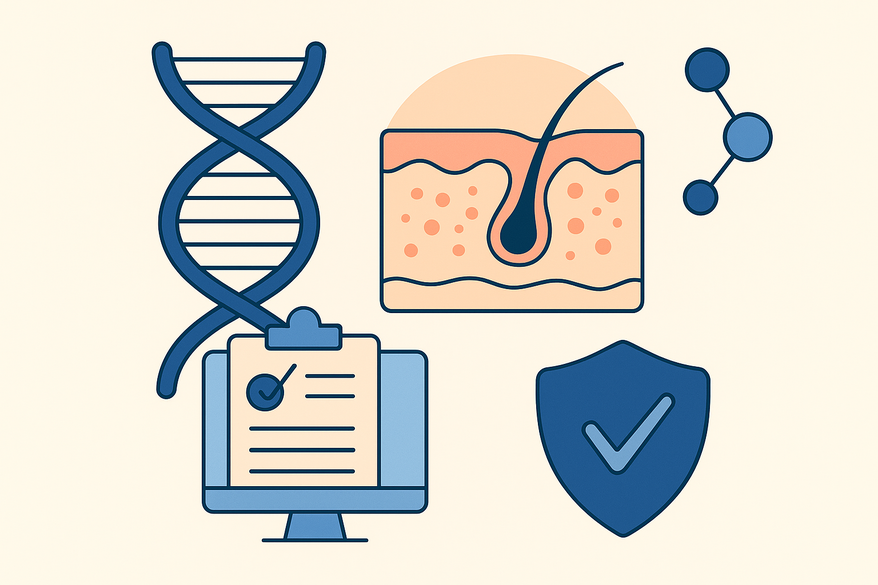Genetic Predisposition to Skin Conditions: How Your DNA Influences Rash Development
Learn how genetic predisposition to skin conditions affects rash development and discover strategies for prevention and personalized care plans.

Estimated reading time: 8 minutes
Key Takeaways
- Inherited risk: Variations in genes like FLG can weaken the skin barrier and raise rash susceptibility.
- Gene-environment interplay: Allergens, stress, climate—and your DNA—work together to trigger outbreaks.
- Risk assessment: Family history and genetic testing guide personalized prevention and treatment.
- Preventive care: Daily emollients, trigger avoidance, and targeted therapies reduce severity.
- AI integration: Apps like Rash Detector offer quick, personalized skin analysis.
Table of Contents
- What Is Genetic Predisposition to Skin Conditions?
- Key Genetic Concepts in Skin Health
- Hereditary Patterns and Family History
- Gene-Environment Interactions in Skin Conditions
- Common Skin Conditions Influenced by Genetics
- Assessing Genetic Risk and Diagnostic Tools
- Prevention and Management Strategies
- Integrating AI Skin Analysis
- Conclusion
What Is Genetic Predisposition to Skin Conditions?
Genetic predisposition refers to inheriting DNA variants that make you more likely to develop skin disorders—even before allergens or stress come into play. When you carry specific gene changes, your skin barrier may be weaker, laying the groundwork for dryness, itching, and early inflammation once triggers appear.
Key Genetic Concepts in Skin Health
To appreciate how genetics shapes skin, consider the DNA → gene → protein pathway:
- DNA: Holds the code for every function in the body.
- Genes: Segments of DNA that instruct cells to build proteins.
- Proteins: Crucial for skin strength, hydration, and repair.
- SNPs (Single Nucleotide Polymorphisms): Tiny DNA changes acting as markers for conditions like eczema or psoriasis.
- FLG mutations: Alter profilaggrin production, leading to a leaky barrier and atopic dermatitis risk.
Hereditary Patterns and Family History
Modes of inheritance:
- Autosomal dominant: Only one copy of a mutated gene triggers the condition.
- Autosomal recessive: Requires two copies for disease to manifest.
For example, exfoliative ichthyosis stems from CSTA gene mutations and follows a dominant pattern—each child of a carrier has a 50% chance of inheriting the rash risk. Observing family clusters of atopic dermatitis or psoriasis can alert you and your doctor to early warning signs.
Gene-Environment Interactions in Skin Conditions
Genes set the stage, but environmental factors pull the trigger. Common contributors include:
- Allergens (pollen, dust mites)
- Stress and sleep deprivation
- Dietary sensitivities
- Climate extremes (cold, dry air)
- UV exposure
Someone with an FLG variant may only flare eczema when exposed to harsh soaps or pollen. By identifying and avoiding these triggers—paired with daily moisturization—you can keep symptoms in check.
Common Skin Conditions Influenced by Genetics
- Atopic Dermatitis (Eczema): Caused by FLG mutations that weaken barrier proteins; presents with dry, itchy, red patches.
- Psoriasis: Polygenic risk involving HLA-Cw6 and IL23R; shows as scaly, red plaques.
- Inherited Ichthyoses: Mutations in genes like CSTA lead to thick, scaly skin across the body.
Assessing Genetic Risk and Diagnostic Tools
Pediatricians often screen newborns if there’s a strong rash history on either side of the family. Genetic options include targeted panels and whole-exome sequencing for severe or early-onset cases. A genetic counselor can explain inheritance patterns, recurrence risks, and family-planning implications.
Prevention and Management Strategies
Preventive Measures
- Emollients: Apply daily to strengthen and hydrate the barrier.
- Irritant avoidance: Use fragrance-free soaps and soft fabrics (see fragrance-free moisturizer suggestions).
- Anti-inflammatory diet: Focus on omega-3s and antioxidants (see anti-inflammatory diet).
Medical Treatments
Topical corticosteroids, calcineurin inhibitors, biologics (e.g., dupilumab for eczema, TNF inhibitors for psoriasis), and phototherapy can all play a role.
Lifestyle Modifications
Stress management, consistent skincare routines, and trigger monitoring help maintain clear, comfortable skin.
Integrating AI Skin Analysis
For a quick, personalized look at your rash risk profile, upload photos to Rash Detector—an AI-driven skin analysis app—and receive an instant sample report:

Conclusion
Your DNA shapes how your skin reacts to the world around you. By understanding genetic predisposition, tracking family patterns, and combining lifestyle and medical strategies, you can reduce rash severity and improve overall skin health. Consult a dermatologist or genetic counselor to tailor a plan that fits your unique genetic profile.
FAQ
- How do I know if I have a genetic predisposition to skin conditions?
A family history of eczema, psoriasis, or ichthyosis suggests a genetic component. Genetic testing and a dermatologist’s evaluation can confirm your risk. - Can lifestyle changes offset genetic risk?
Absolutely. Daily moisturization, trigger avoidance, stress reduction, and an anti-inflammatory diet can all mitigate genetic vulnerabilities. - Is genetic testing necessary for all skin condition patients?
Not always. Testing is most useful in severe, early-onset, or treatment-resistant cases, or when planning for future children. - How does AI skin analysis work?
AI apps analyze photos for color, texture, and lesion patterns, compare them against large datasets, and provide risk assessments and care suggestions.





